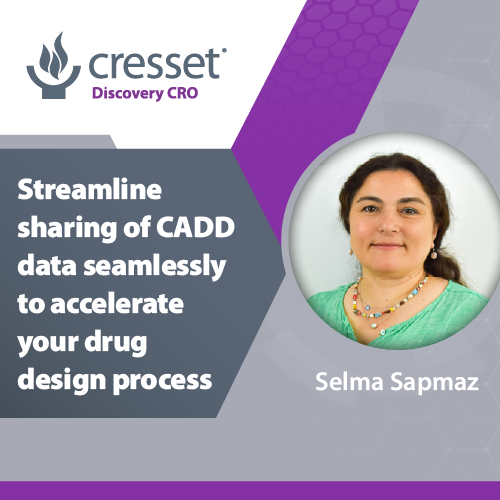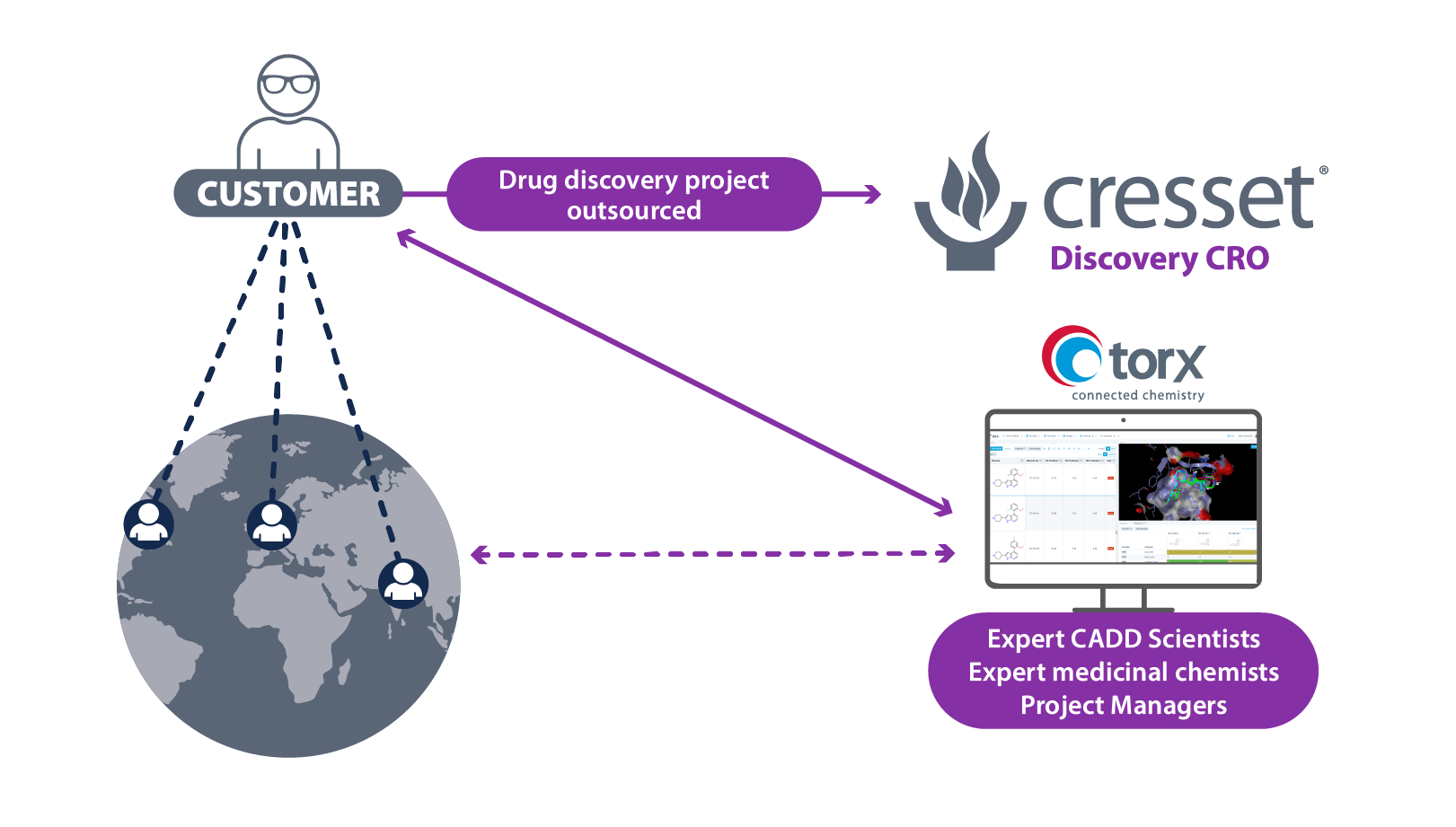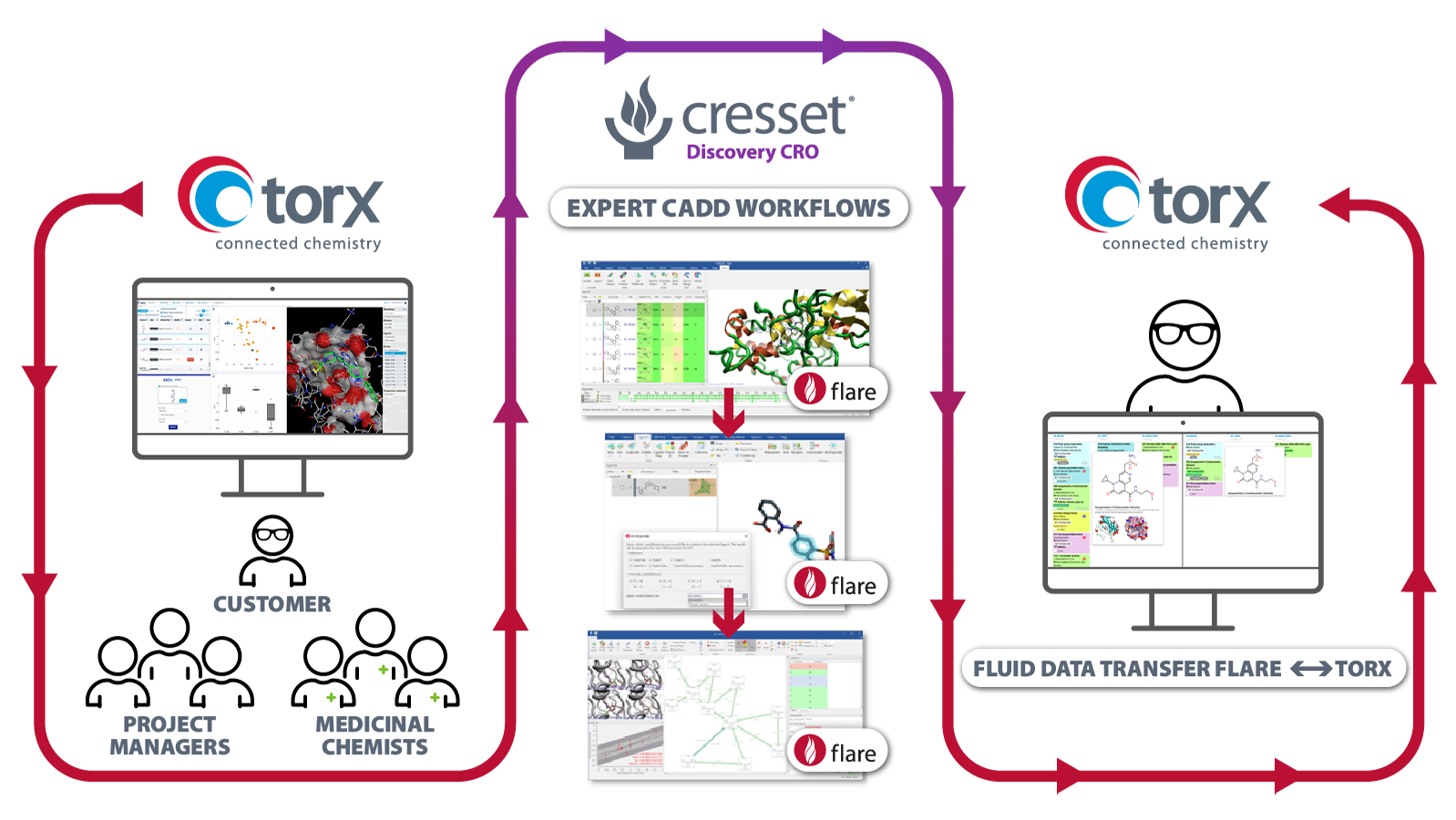Streamline sharing of CADD data seamlessly to accelerate your drug design process

In this article, we outline some of the challenges in sharing chemistry data and demonstrate how Cresset Discovery collaborates seamlessly with customers and external partners using the Torx® cloud-based platform. The integration of Torx within Cresset’s CADD software streamlines sharing of project data and facilitates secure communication of information with customers and other external partners (Figure 1).

Figure 1: Possible interaction routes between Cresset Discovery, our customer, and other stakeholders in a drug discovery project using Torx
Challenges
Effective communication is central to efficiently progressing around the DMTA cycle. From hypotheses and molecular designs, followed by synthesis, biological testing and data analysis, productivity of a project team depends on efficient data sharing between medicinal chemistry/computational chemistry/CRO partners. Unfortunately, this can be a tedious and time-consuming task when data and chemistry designs are stored in a range of file formats. Sharing hypothesis within a team requires the preparation of reports/presentations that must then be uploaded to shared drives. The transfer of chemical data can often lead to loss, or even erroneous transfer, resulting in duplication of work when structures or data must be re-entered manually. From a scientific perspective, compound ideas are typically represented in 2D and taken forward for synthesis on the assumption that the molecule fits the 2D pharmacophore. However, this doesn’t make biological sense when viewed as a 3D conformation and in the context of the protein binding site. This wastes synthetic and computational chemistry, as well as biological testing resources.
How Cresset Discovery uses Torx to streamline data transfer for discovery projects
Cresset Discovery uses Torx, a web-based, molecule aware, DMTA platform to communicate with our customers.1 The platform centralizes all project data, connecting discovery teams and partners securely, so that the latest information is always accessible, in the right format at the right time. All project compounds, syntheses, hypotheses, data and challenges are captured and tracked in a secure and fluid fashion, avoiding duplication of work between colleagues and partners.
Cresset Discovery utilizes a seamless integration between the ligand and structure-based drug design solution Flare2 and Torx to efficiently retrieve customer data and carry out further computationally enhanced 3D-modeling. The analyses are then shared in real time with customers and other external partners who may then engage with their third parties for further synthesis work. Using the Torx platform eliminates duplication of work through data sharing and the need to generate slides for project updates, or to track team resources.
An example of a Cresset Discovery workflow used is shown in Figure 2 for a Cyclin-Dependent Kinase 9 (CDK9) inhibitors case study carried out by our team to demonstrate the efficiency of the application.3,4
When a customer uses Torx to share SAR compounds and design ideas with Cresset Discovery, these can be fetched seamlessly into Flare using the Torx API and a dedicated extension to Flare. In this example (Figure 2), an automated Hit Expansion of the lead compound was enumerated, to generate close analogue ideas. The candidates were then triaged by running Flare FEP binding predictions. The results of the binding predictions were sent back in real time to Torx, enabling the project team to make better, informed decisions and prioritize the best molecules for synthesis. There was no need for multiple uploads and download of structures and unnecessary presentation slides.

Figure 2: An example of a Cresset Discovery workflow using Torx with stakeholders
Conclusion
When partnering with Cresset Discovery CRO, customers benefit from secure, real-time sharing of project data and communications utilizing the seamless integration of Torx within molecular modeling solution Flare. The enhanced CADD analyses and models are shared in real time, leading to models being adopted by multiple stakeholders, improving the design process and reaching your next project milestone faster.
Engage Cresset Discovery to accelerate your project
Cresset Discovery serves as a true partner for computational drug discovery. Our expert team has a breadth of experience across medicinal and computational chemistry and biology, and works alongside you to deliver your project goals. Whether you are looking to validate early-stage targets, find new hits or optimize them to deliver a clinical candidate, the team’s deep technical expertise spans from ligand, fragments, and structure-based drug discovery capabilities (SBDD) across a wide range of therapeutic targets. Partnering with us, you will benefit from the robust combination of our experienced scientists applying the right technology at the right time, to accelerate your project cost-effectively.
Watch our webinars to learn more about Streamlining collaboration and information delivery of outsourced discovery projects and Streamlining CADD and med chem communications.
To learn more about how we can support your project, request a no-risk confidential discussion with our team. If you’d like to explore the possibility of using our software tools on your own project, then you can also request a free CADD software evaluation, or Torx demonstration.
References
- Torx®, Torx Software®, Litlington, Cambridgeshire, UK; https://www.torx-software.com
- Flare™, Cresset®, Litlington, Cambridgeshire, UK; https://www.cresset-group.com/flare/; Cheeseright T., Mackey M., Rose S., Vinter, A.; Molecular Field Extrema as Descriptors of Biological Activity: Definition and Validation J. Chem. Inf. Model. 2006, 46 (2), 665-676; Bauer M. R., Mackey M. D.; Electrostatic Complementarity as a Fast and Effective Tool to Optimize Binding and Selectivity of Protein–Ligand Complexes J. Med. Chem. 2019, 62, 6, 3036-3050; Maximilian Kuhn, Stuart Firth-Clark, Paolo Tosco, Antonia S. J. S. Mey, Mark Mackey and Julien Michel Assessment of Binding Affinity via Alchemical Free-Energy Calculations J. Chem. Inf. Model. 2020, 60, 6, 3120–3130
- Rapid approaches to new scaffold generation - accelerate hit-to-lead
- Prioritizing the Most Promising Virtual Screening Hits





















